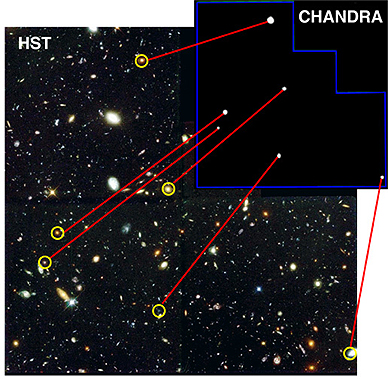

The X-ray emitting objects discovered by the research team are a distant galaxy thought to contain a central giant black hole, three elliptically shaped galaxies, an extremely red distant galaxy, and a nearby spiral galaxy.
"We were expecting about five X-ray sources in this field,"said Professor Niel Brandt of Penn State University, University Park, and one of the leaders of the research team that conducted the survey. "However, it was very surprising to find that none of the X-ray sources lined up with any of the submillimeter sources."
The submillimeter sources are extremely luminous, dusty galaxies that
produce large amounts of infrared radiation. Because they are over ten
billion light years from Earth, their infrared radiation is shifted to
longer, submillimeter wavelengths as it traverses the expanding universe.
The primary source of the large power of the submillimeter sources is
thought to be an unusually high rate of star formation, or the infall,
or accretion of matter into a giant black hole in the center of the galaxy.
X-ray observations provide the most direct measure of black hole accretion
power. X-rays, because of their high energy, would be expected to pass
through the gas and dust in these galaxies, unlike visible light.
"That means," Brandt explains, "Either there is an enormous amount of star formation in those galaxies, or these objects contain the best-hidden black holes in the universe."
Chandra's increased spatial resolution--the capability to concentrate X-rays into a smaller area--also increases its sensitivity for detecting fainter X-ray sources than ever before. "Many of our sources are fainter than any source that was detected in the deepest observations by all previous X-ray observatories," Hornschemeier says.